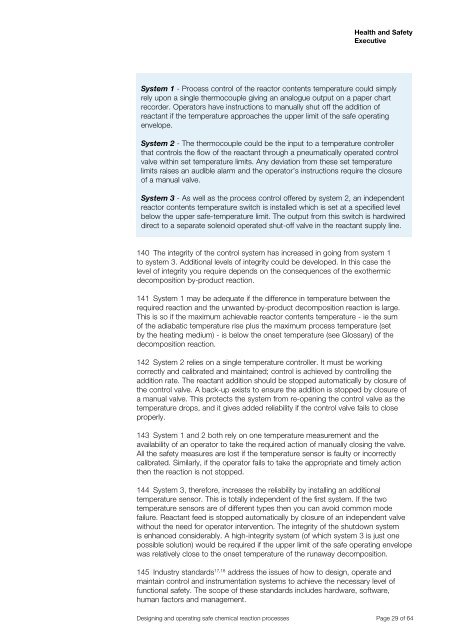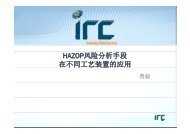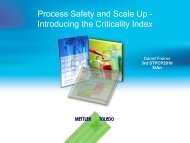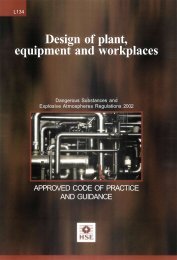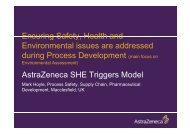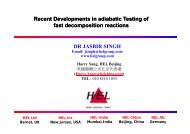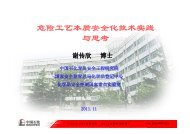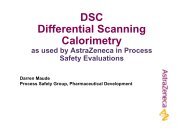Designing and operating safe chemical reaction processes HSG143
Designing and operating safe chemical reaction processes HSG143
Designing and operating safe chemical reaction processes HSG143
Create successful ePaper yourself
Turn your PDF publications into a flip-book with our unique Google optimized e-Paper software.
Health <strong>and</strong> SafetyExecutiveSystem 1 - Process control of the reactor contents temperature could simplyrely upon a single thermocouple giving an analogue output on a paper chartrecorder. Operators have instructions to manually shut off the addition ofreactant if the temperature approaches the upper limit of the <strong>safe</strong> <strong>operating</strong>envelope.System 2 - The thermocouple could be the input to a temperature controllerthat controls the flow of the reactant through a pneumatically operated controlvalve within set temperature limits. Any deviation from these set temperaturelimits raises an audible alarm <strong>and</strong> the operator’s instructions require the closureof a manual valve.System 3 - As well as the process control offered by system 2, an independentreactor contents temperature switch is installed which is set at a specified levelbelow the upper <strong>safe</strong>-temperature limit. The output from this switch is hardwireddirect to a separate solenoid operated shut-off valve in the reactant supply line.140 The integrity of the control system has increased in going from system 1to system 3. Additional levels of integrity could be developed. In this case thelevel of integrity you require depends on the consequences of the exothermicdecomposition by-product <strong>reaction</strong>.141 System 1 may be adequate if the difference in temperature between therequired <strong>reaction</strong> <strong>and</strong> the unwanted by-product decomposition <strong>reaction</strong> is large.This is so if the maximum achievable reactor contents temperature - ie the sumof the adiabatic temperature rise plus the maximum process temperature (setby the heating medium) - is below the onset temperature (see Glossary) of thedecomposition <strong>reaction</strong>.142 System 2 relies on a single temperature controller. It must be workingcorrectly <strong>and</strong> calibrated <strong>and</strong> maintained; control is achieved by controlling theaddition rate. The reactant addition should be stopped automatically by closure ofthe control valve. A back-up exists to ensure the addition is stopped by closure ofa manual valve. This protects the system from re-opening the control valve as thetemperature drops, <strong>and</strong> it gives added reliability if the control valve fails to closeproperly.143 System 1 <strong>and</strong> 2 both rely on one temperature measurement <strong>and</strong> theavailability of an operator to take the required action of manually closing the valve.All the <strong>safe</strong>ty measures are lost if the temperature sensor is faulty or incorrectlycalibrated. Similarly, if the operator fails to take the appropriate <strong>and</strong> timely actionthen the <strong>reaction</strong> is not stopped.144 System 3, therefore, increases the reliability by installing an additionaltemperature sensor. This is totally independent of the first system. If the twotemperature sensors are of different types then you can avoid common modefailure. Reactant feed is stopped automatically by closure of an independent valvewithout the need for operator intervention. The integrity of the shutdown systemis enhanced considerably. A high-integrity system (of which system 3 is just onepossible solution) would be required if the upper limit of the <strong>safe</strong> <strong>operating</strong> envelopewas relatively close to the onset temperature of the runaway decomposition.145 Industry st<strong>and</strong>ards 17,18 address the issues of how to design, operate <strong>and</strong>maintain control <strong>and</strong> instrumentation systems to achieve the necessary level offunctional <strong>safe</strong>ty. The scope of these st<strong>and</strong>ards includes hardware, software,human factors <strong>and</strong> management.<strong>Designing</strong> <strong>and</strong> <strong>operating</strong> <strong>safe</strong> <strong>chemical</strong> <strong>reaction</strong> <strong>processes</strong> Page 29 of 64


